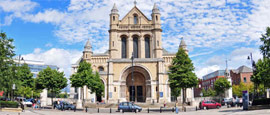More Victorian mansion than a traditional fortress, Belfast Castle combines Scottish baronial style with baroque features and owes much of its popularity to its superb location on the lower slopes of Cave Hill. Offering the best possible panorama of the city, visitors can find out more about the John Lanyon-designed Castle in the Visitor Centre on the second floor. Better still - take afternoon tea in its Cellar Restaurant.
Things to see in Belfast
Tourist offices
Address: 9 Donegall Square, Belfast, Northern Ireland, BT1 5GB, United Kingdom
Tel: +44 28 9024 6609.
Opening Hours:
Mon-Sat 0900-1730, Sun 1100-1600 (Oct-May); Mon-Sat 0900-1900, Sun 1100-1600 (Jun-Sep).
www.visitbelfast.comThe large Visit Belfast Welcome Centre, opposite Belfast City Hall, is a treasure trove of information from leaflets and themed keepsakes to travel information and highly knowledgeable staff. There are also information desks at both airports.
The Belfast Visitor Pass offers unlimited travel on all Metro buses, certain NI Railways and Ulsterbus routes. It’s available for one, two or three days and includes special offers and discounts for visitor attractions, tours, cafes, restaurants and shops. The pass can be purchased online or at the Belfast Welcome Centre, Belfast airport tourist information desks or at any Translink station in Belfast.
Rising to 7.6m (25ft) in height, the Peace Wall is a prison-like fence of concrete, corrugated steel and wire that separate nationalist and loyalist neighbourhoods. A psychical reminder of the division caused by The Troubles, tours take in the Falls and Shankill Roads and cover clash points as well as the murals that depict those lost in three decades of fighting. For historical context, visit on a black cab tour or with a guide, most of whom have experienced the Troubles first-hand.
Originally peddling poultry, butter and eggs in the late 1800s, a refit and reshuffle in 1997 have turned this Victorian arcade into Belfast’s trendiest shopping destination. Now selling everything from fish to flamenco music, there are nearly 300 stalls to check out, with a variety market on Fridays, food and crafts being sold on Saturdays and a mixture of both on Sundays.
Possibly the greatest museum in the whole of Ireland, the six-storey Titanic Belfast sits near the docks where the ‘unsinkable’ ship was built. The same height as its namesake – and designed suspiciously like an iceberg – this informative, interactive and entertaining museum takes visitors from conception and launch through to the eventual sinking and discovery of Belfast’s most infamous ship. With original documents, immersive rides, virtual tours, recreated cabins, survivors’ stories, a cinema showing the wreckage and even a little Celine Dion, the city finally has a Titanic worth shouting about.
These lovely gardens, laid out in the 19th century by the Botanic and Horticultural Society, provide a wonderful respite from the University Quarter. Now a public park, its beautiful cast-iron and curvilinear glass Palm House remains the centrepiece. The Tropical Ravine reopened in 2018 after a major restoration, while its rose garden, Bowling Green and walking routes leave plenty to peruse.
As much a work of art as a place for drinking, the interior of this Victorian gin palace is richly decorated with coloured glass, stylised tiles, arcaded mirrors and polished marble. Inspired by his travels, landlord Patrick Flanagan encouraged Italian artists working on Belfast’s churches to stylise the boozer in 1885. Now owned by the National Trust, it’s one of Ireland’s most infamous imbibing dens.
Popular with ex-inmates (so we’re told), the Crumlin Road Goal is a large Victorian prison that carries the cold chill of a condemned man. Hour-long tours revive its stories of semtex bombs, executions, unmarked graves and escapees, while allowing visitors to peek into cells and gawp at the gallows. Built to hold 500 prisoners, the Crum burst at the seams during the Troubles with Ian Paisley, Martin McGuinness, Michael Stone and Bobby Sands among its notable boarders.
Expect to lose half a day at Northern Ireland’s national museum and art gallery. A medley of British, Irish and European paintings, local crafts and Irish history, its ground floor exhibition has a good overview of the Troubles. The finest pieces here include the Spanish Armada treasure and Takabuti’s shrivelled mummy from 660BC. Her reconstructed face sits in the cabinet opposite.
You could easily spend a weekend dipping in and out of churches in Belfast, but if you’re going to visit one, make it the quirky Sinclair Seamen's Presbyterian Church. Built in an L-shape to accommodate up to 50 sailors on shore leave, the church is heavy on the nautical theme with the prow of a ship coming from its altar, a wheel and capstan from a sunken vessel and the bell of HMS Hood calling worshippers to service.
SS Nomadic is the last remaining ship built by the White Star Line. This plucky tender, which took passengers to RMS Titanic from Cherbourg, has been fully restored and now relives its glory days in a dry dock. Interactive exhibits, a holographic crew (press the bell at the bar) and dressing up boxes all take visitors back to 1912. Retired in 1968, Nomadic was a restaurant in Paris before returning to Belfast.
Do you have any Feedback about this page?
© 2025 Columbus Travel Media Ltd. All rights reserved. No part of this site may be reproduced without our written permission, click here for information on Columbus Content Solutions.








 You know where
You know where